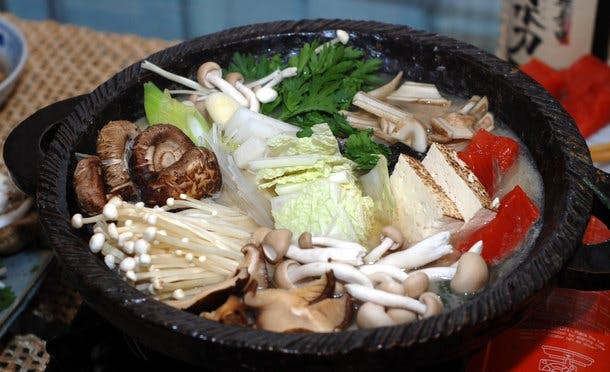
hotpot 101, or window into japanese cuisine
Japanese hotpot cooking, or 'nabe,' is a wonderful window into regional Japanese cuisine and traditional cooking. Explore the use of Japanese ingredients like shiitake mushrooms, Napa cabbage, chrysanthemum leaves, Japanese leeks, tofu, and non-grain based noodles, all boiled or simmered in a flavorful and healthy water-based broth called 'dashi.' Experience the unique flavors and seasonality of Japanese ingredients through the comforting and enjoyable hotpot cooking, reflecting the essence of Japanese food culture.
"There are no rules for making nabe," said Chef Ono, as we got to talking about Japanese hotpot cooking to me the other night at Matsuri restaurant. I've been fascinated by this homey soul food, as readers of the Report know, and wanted to learn more -- and understand what hotpots say about Japanese cuisine as a whole.
First, what about the ingredients? While different styles of hotpot reflect distinct regional identities, there seems to be a clutch of foods that are central to these dishes:
-- shiitake, shimeji and enoki mushrooms
-- hakusai (Napa cabbage)
-- shungiku (chrysanthemum leaves)
-- naga negi (Japanese leeks)
-- tofu
-- non-grain based noodles (like arrowroot kuzukiri, harasume (bean thread noodles), or konyaku noodles)
The vegetables here I believe are all seasonal winter vegetables (right?). Even in far northern Akita Prefecture snow country I saw farmers dig out hakusai and negi that they buried under the snow and a layer of dirt to preserve them -- amazing. But, as the chef emphasized, this list isn't hard and fast. "You could put in anything you want," he said. For example, he explained there's a traditional hotpot from Tokyo called negi-ma-nabe -- leek and tuna nabe, just those two ingredients, that's it. Both are signature foods of the Tokyo area.
The chef describing this Tokyo-style hotpot got me thinking of the empirical aspect of Japanese cooking. Since this food culture is such an old one, it seems that certain combinations that taste delicious have become codified into the cooking over the years -- like tuna and leek or other regional hotpot combinations or even that list above. As the chef pointed out, too, the list I mention is naturally well-balanced and healthy -- protein, carbs, fiber, vitamins, it's got it all. (Hey, the author Michael Pollan would approve!)
What about the broth? Here the chef made a fascinating point: He explained that Western cooking is oil based, that is, fats like butter and oil form the flavor foundation of the cuisine, while Japanese cuisine is traditionally water based. Dashi, broth, underlies Japanese cooking. This "water", whether prepared with konbu (kelp), dried fish, fresh fish parts, dried mushrooms etc., then infuses other ingredients. The chef added that even if you cook wagyu, Japan's richly marbled beef, the traditional way -- as thin slices boiled in a shabu-shabu hotpot -- the fat comes out of it. Hotpots are a great example of this idea. The wide range of wan mono -- steaming, simmering, boiling -- comes to mind, too.
What about the flavors? A friend of mine, a serious French and Italian gastronome, had dinner recently at my pal Reika Yo's En Japanese Brasserie. His experience with Japanese cuisine had been limited to sushi, so he was really surprised by the flavors and cooking styles he encountered. He thoroughly enjoyed his dinner but compared it to the difference between listening to Western classical music and Japanese classical music -- the rhythms, tempo, tone, etc., totally unrelated. I think he makes a good point. When I first started tasting real Japanese cooking, I sometimes found dishes bland. It took me a while for my palate to appreciate the subtleties of the "water" and appreciate the ingredients that drive this cooking.
(Now I have the opposite problem: I was invited to dinner last week to a highly-regarded Modern American place last week was overwhelmed by the fats and butter. As Chef Ono joked, "I'm ruined" now that I'm eating so much Japanese!)
But how do you learn about these flavors and ingredients? How do you experience what chrysanthemum leaves or burdock actually taste like?
Hotpot to the rescue!
"Nabe are a great way to get to know ingredients unfamiliar in the West," the chef said as we sat in his office in the back of the kitchen. I see what he means. What I love about hotpots, aside from how they're such a wonderful window into Japanese regional food culture, is they're such an easy, homey and thoroughly enjoyable way to experience and begin to appreciate Japanese ingredients (or even ingredients we're familiar with, like salmon -- but cooked in a Japanese "water" way). Whether you cook a hotpot with miso or konbu broth, "shungiku tastes like shungiku, shiitake tastes like shiitake," the chef explained. "And the dashi doesn't have such a strong flavor."
What do you think of all this? Do you have anything to add or do you disagree with anything here? Please comment and enlighten us... (Thanks)
